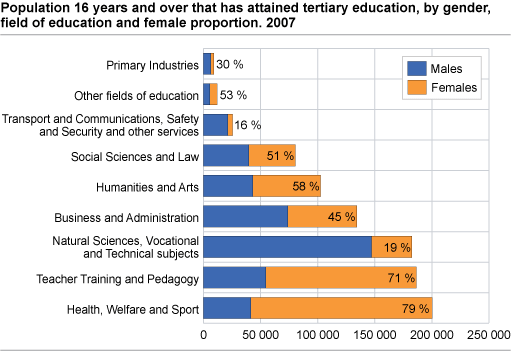Content
Published:
This is an archived release.
Highest education in university counties
The proportion of people with less than upper secondary education decreases, whereas the proportion of people who has attained a tertiary education increases. Counties where universities are located have a higher proportion of the population with a tertiary education than remaining counties.
Four out of ten people in Oslo, aged 16 years and older, have attained a tertiary level of education. For all counties, at least 19 percent of the population has attained a tertiary level of education.
|
Persons with unknown level of education are excluded in calculating proportions for the population’s level of education. Number of persons with unknown level of education is by far larger in Oslo than in other counties. A large proportion of people with unknown level of education are immigrants. |
Highest attained level of education among 30 to 39-year-olds
More than 40 per cent of the population aged 30 to 39 years has attained a tertiary level of education. For women, 49 per cent of 25 to 29-year-olds have attained tertiary level of education.
In the age group 40 years and over a larger proportion of women than men has below upper secondary education as their highest attained level of education. However, in the age group 16 to 39 years the proportion of men with below upper secondary education is higher than for women.
More and more people pursue an education after compulsory education
The proportion of people who has attained below secondary education has decreased over the last 20 years. In 2007, only 30 per cent had attained below upper secondary as their highest attained level of education - compared with 45 per cent in 1985. The proportion of people with an upper secondary education has been close to 43 per cent within the same period. The population with attained tertiary level of education has doubled over the last two decades - from 13 per cent in 1985 to 26 per cent in 2007.
Most people with tertiary education is within the field of Health, Welfare and Sport
Almost 21 per cent, or close to 200 000, of those who have attained a tertiary education is within the field of Health, Welfare and Sport. 20 per cent have attained a tertiary education in Teacher Training and Pedagogy and 19 per cent in Natural sciences, Vocational and Technical subjects. Least people have a tertiary education in Primary Industries - only 1 per cent or close to 9 000 people.
| 2000 | 2005 | 2006 | 2007 | ||||||||||||||||||||||||||||||||||||
|---|---|---|---|---|---|---|---|---|---|---|---|---|---|---|---|---|---|---|---|---|---|---|---|---|---|---|---|---|---|---|---|---|---|---|---|---|---|---|---|
| Total | 12 092 | 15 138 | 15 895 | 16 709 | |||||||||||||||||||||||||||||||||||
| Males | 9 095 | 10 853 | 11 279 | 11 717 | |||||||||||||||||||||||||||||||||||
| Females | 2 997 | 4 285 | 4 616 | 4 992 | |||||||||||||||||||||||||||||||||||
More women with an advanced research degree
The number of people who have attained an advanced research degree has increased over the years. Almost one out of 300 aged 16 years and over had earned a PhD degree in 2000, whereas one out of 200 had earned a PhD in 2007. The female proportion among those who have attained an advanced research degree raised from close to 25 per cent in 2000 to 30 per cent in 2007.
In OECDs publication Education at a Glance 2007 and indicator A3 the percentage of advanced research degrees awarded to females is presented for OECD-countries in 2004/2005. In Norway, 40 percent of advanced research degrees were awarded to females. Back in 1997/1998 the proportion was 29 per cent. In Portugal, Iceland and New Zealand more women than men were awarded with an advanced research degree in 2004/2005 - 57, 57 and 52 per cent respectively. In 1998/1999 no OECD-countries had a higher proportion of women than men who were awarded with an advanced research degree.
Recent figures from NIFU STEP (Norwegian Institute for Studies in Innovation, Research and Education) indicate that the female proportion will continue to grow in Norway. According to NIFU STEP 45 per cent of all doctoral degrees were awarded to women in 2007.
Tables:
- Table 1 Population 16 years and over, by level of education, gender and county of residence. 2007
- Table 2 Population 16 years and over, by level of education and municipality of residence. 2007
- Table 3 Population 16 years and over by, by level of education, gender and age. 2007. Per cent
- Table 4 Population 16 years and over, by level of education and field of education. 2007
Contact
-
Andrine Stengrundet
E-mail: andrine.stengrundet@ssb.no
tel.: (+47) 95 48 60 28
-
Anne Marie Rustad Holseter
E-mail: anne.marie.rustad.holseter@ssb.no
tel.: (+47) 93 45 98 35
-
Maj-Lisa Lervåg
E-mail: maj-lisa.lervag@ssb.no
tel.: (+47) 45 68 84 72

